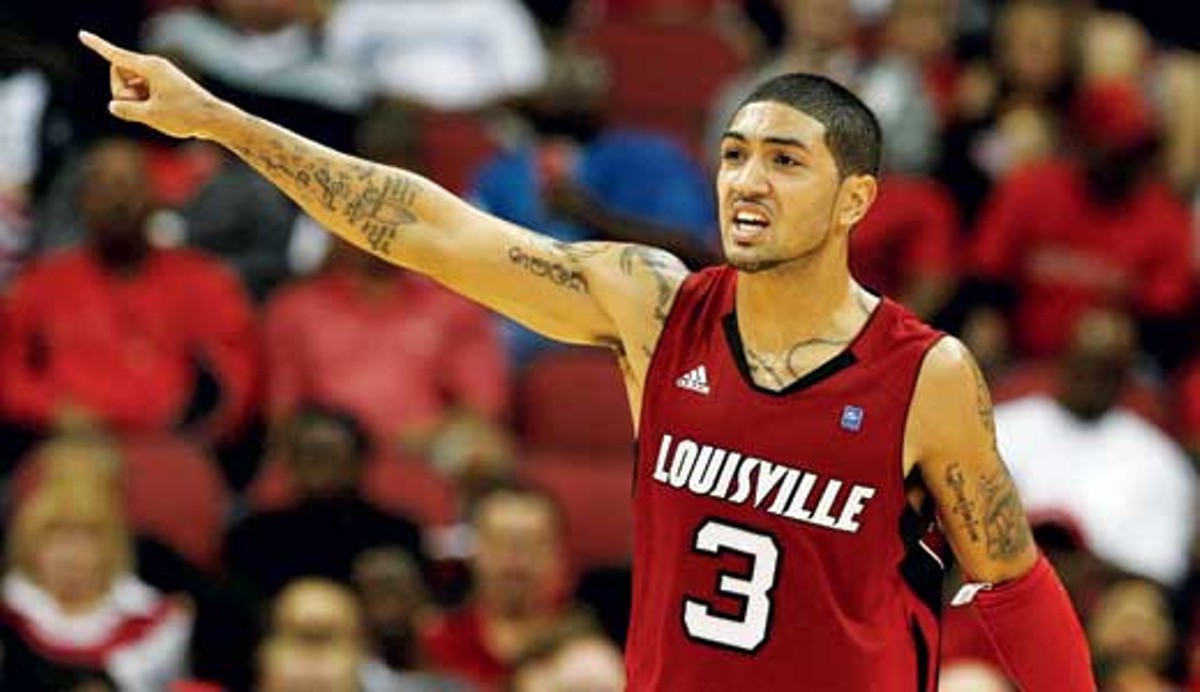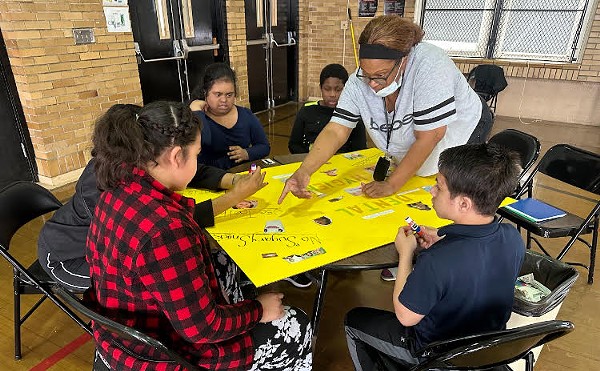Louisville grabbed a No. 4 seed in the NCAA Tournament’s Southwest Regional and begins tournament play Thursday against Morehead State in Denver, Colo. But it probably doesn’t matter much who or when or where the Cardinals play. Louisville brings the same game every time. And it either works — or it doesn’t.
But who or when or where might matter plenty to any team unlucky enough to be dropped into a bracket where it could meet Louisville. Ohio State is the tourney favorite, and Louisville (25-8) is considered the 11th best team, at least according to the Associated Press. But nobody in their right mind would want to play the Cards. It’s a nightmare.
First of all, Louisville pours three-point shots at the opponent. That’s always trouble. But even worse is Louisville just won’t let a team play. No matter where you look, where you try to dribble, whom you’d like to pass to, or how much you might wish to unfold your super-duper offense, Louisville just won’t let you do it. And you better have the ball sewn into your passport pocket, because Louisville has these troublesome guards who’ll pick your pocket faster than Peter Piper can say Preston and Peyton.
Louisville guard Peyton Siva led the Big East Conference in steals, and Preston Knowles wasn’t far behind. “Preston and I have had this competition since the start of the season to see who can get the most steals, and right now, I’m a little ahead of him,” Siva says. “The reason that’s important is because defense is what gets our team going.”
Indeed it does, because Siva and Knowles don’t just settle for steals. They’re greedy. They swipe the basketball, then make a beeline to the basket to cash that baby in for points.
Broadly, it’s called a fast break. But Louisville’s version doesn’t look like the fast break your daddy learned. The traditional fast break is where guys fan out and fill the lanes, get their spacing and try to time themselves to where a nice feed results in an easy lay-in. Back in the Glory Days, Louisville (and other teams) would practice 3-on-2 fast breaks until the cows came home. But Louisville’s guards today don’t do it that way.
“Just Go!” says Siva, a 5-10 sophomore. “Get the ball. Get out on the break and run. Get the points. Try to get fouled.”
Do it yourself, and do it fast. Passes are OK, but the main thing is go-man-go.
“When we get out on a break like that, that’s when we’re at our best,” Siva says. “Flying around, getting steals, trying to get a transition bucket, that’s us at our best. We’re not a half-court team. When we get in the half-court game, everything hurts us. So we’ve got to get on the break, and we’ve got to play at our own pace. And that starts on defense with the guards.”
And often ends with three-point shots, says Chuck Nalevanko, a former Louisville player (1970), Seneca High School coach and unofficial LEO college basketball analyst.
“Louisville just kills people when they get into a penetrate-and-dish game to set up the three-point shots,” Nalevanko says. “They hit two or three threes in a row, then they crank up the press and everybody gets excited. They play harder. They’re diving on the floor.”
Which for Louisville is the difference between winning and losing, says coach Rick Pitino.
After an overtime victory (Louisville was 3-1 in overtime games this season), Pitino told WHAS radio broadcaster Paul Rogers that his team holds just a hairbreadth edge. “It’s obvious we can beat anybody,” Pitino says. “But we don’t knock anybody out.”
No KO’s maybe, but opponents might feel like they’ve run into a swarm of very unhappy hornets.
“Sooner or later, they’re going to wear you down,” says ESPN analyst Jay Bilas.
And not just by running opponents out of gas.
“Controlling your head,” says Bilas’ broadcast partner Jim Raftery. “Doing all those things they do down the stretch.”
That’s the nightmare: a full court press, with three-point bombs dropping out of the clouds.
“But when those shots aren’t going, that’s a problem for Louisville,” Nalevanko cautions. “It’s a little bit different in a grind-it-out game, and I’m not real sure we’re good in a grind-it-out game.”
If he were plotting to stop Louisville, Nalevanko says he would guard the perimeter to take away the threes.
“I’d make the center, Terrence Jennings, beat me,” Nalevanko says. “Play them man-to-man, stay out, don’t converge in your typical ‘help defense.’ Make Jennings score 30 points and see if Louisville can beat you.”
An interesting notion. But Jennings contends he doesn’t care a thing about scoring 30.
“We do it with our defense,” Jennings says. “Once we get that working, we’ll be OK.”
The 6-foot-10 junior’s natural speed fits in with the Cards attack. “My freshman year, I was really running up and down the court, but I wasn’t running with a purpose. I run well, but now I’m picking the spots I want to run to — try to get my feet in the paint and put myself in position to score.”
Louisville gets oversized play from undersized 6-4 forward Kyle Kuric, whose specialty is raining down three-point missiles from the left-hand corner — “Kyle’s Corner.” Sometimes — as when he destroyed Syracuse in the final game at Freedom Hall in 2009 — Kuric’s outbursts catch fans by surprise.
But according to Knowles, they shouldn’t.
“I room with Kyle on the road, and he would always be talking about these ways he’d figured out that I could score,” Knowles says. “I’m saying, ‘Why don’t you do that, Kyle? Why don’t you do all that and score, yourself?’ ”
And so he has.
A passing moment from a season ago gets one thinking that Kuric might not be so much shy (as he’s advertised) as deferential. Just waiting his turn.
High-scoring center Samardo Samuels had just notched a big game and reporters were clustered all around him. Kuric’s locker was right next to Samuels’, and as the cameras focused closer, Kuric was dressing quietly to the side, kind of reaching in past the crush to grab a pair of socks or shoes. “Sorry,” a reporter said to Kuric. “We’re spilling over in front of your spot.”
“Oh, that’s OK,” said Kuric. “I don’t mind.”
Interestingly, Samuels, the go-to scorer, is now in the pros, but Louisville is a better team — with talent spread out among more players. Chris Smith, Mike Marra and Stephan Van Treese all now log serious minutes. And Louisville has added a very tall and promising freshman center, Gorgui Dieng. In the minus column, 6-8 forward Rakeem Buckles was injured early, came back, then went out for the season with a knee injury. Buckles is a natural rebounder — and rebounding remains a constant problem for Louisville.
Marra has a (sometimes) electric three-point stroke, but concentrates more on the rest of his game. And the opponent’s game.
“I was looking around for a way to help the team, and I thought I could really make a contribution by digging into the scouting report to know exactly what’s going on,” Marra says.
League-leading Pittsburgh signals plays from the bench with cue cards, but Marra broke the code, and as the Panthers called plays, he yelled them out to his teammates.
It’s not the only trick Louisville has up its sleeve.
Louisville fan Jim Knoer, a kind of a church-league playing legend around town, has been keeping an eye on Pitino.
“He’s brought this team along perfectly,” Knoer says. “Before the season, he was saying they were going to get up and down the court and contest everything on defense — and he got them playing that way. He began the season playing man-to-man defense. But when they got into the Big East, he suddenly switched to some kind of a match-up zone, that’s worked. It’s complicated, but his players have all bought into it. They’re all like little cogs in this thing.”
So just when you think a big team will stick the ball down Louisville’s throat, they don’t.
Pitino, now in his 25th season as a head coach and 10th at Louisville, says his defense is more about attitude than technique.
“I’ve gone five times to the Final Four,” Pitino says. “One thing I’ve learned: If your moods are generated by offense, you won’t be a good tournament team. If your moods are generated by defense, you’ll be a good team.”
But defense, it says here, is not a certain substitute for offense in college basketball. Like it or not, Louisville doesn’t have a 6-foot-5 All-American to lead the way. Whatever defensive ju ju Louisville’s got didn’t stop Georgetown or Villanova — or Drexel. And Kentucky freshman guard Brandon Knight was unfazed.
So it probably is a very good thing for Louisville that Kentucky (25-8 and the No. 4 seed in the East Regional) ended up in an opposite bracket. Far Away, Kentucky opens play Thursday in Tampa against Princeton (25-6), and the two Kentucky powers could not meet until the final game.
Both teams’ opponents are No. 13 seeds. Princeton tied Harvard for the Ivy League championship, but beat Harvard in a playoff game for the NCAA bid.
Morehead (24-9), champions of the Ohio Valley Conference, has a throwback warrior in Kenneth Faried, who this season established an all-time career NCAA rebounding record — 1,590 rebounds to pass Tim Duncan of Wake Forest. Morehead would not mind busting Louisville’s bracket. The Eagles have been on a big upswing in recent seasons and evidently scared both Ohio State and Florida into dropping them from future schedules.
But it’s a funny thing about Louisville: There seems to be no pressure about how far the team should advance in the tournament. A season ago, the Cards turned in one of their worst tourney efforts in history, dropping dead to California in the first game. But a loss to Morehead State, or another team, would not tarnish the team’s status with fans. This Louisville team has something special.
“Obviously, the shooting, and their scrappiness,” Nalevanko says. “Their ability to battle bigger and stronger people. I’m amazed at how we get away with that. It’ a collective kind of thing that Pitino has them realizing — that that’s the way they can play. And they’re willing to do it. They’re a fun team to watch.”
Yes. But for opponents, not so much.
No. 1 seeds have dominated the national championship in the past decade or so. Duke twice, North Carolina twice, Florida twice, Connecticut, Syracuse, and so on. But that could change.
Nalevanko believes Ohio State and Kansas are solid, both 32-2 and correctly ranked No. 1 and 2. But after that?
“I do think this is the year there could be some major upsets,” Nalevanko says. “Like maybe a 16 seed beating somebody. Or a15. The gap is getting closer.
“A team I like is San Diego State. They’re a 2 seed, staying out West, and will be very hard to beat. They’ve got a bunch of 6-4 to 6-9 kids who are just great athletes, and they’re well coached.”
The Aztec’s (32-2) coach is veteran Steve Fisher, from long ago fame at Michigan. “The guy didn’t forget how to coach just because he went out West, and now he’s put together some pretty good players.”
Southern Indiana Sal, who is coy about his real name being mentioned because, we assume, he’s going to go around and get in every office pool in town, picks Ohio State. “I know they’re a little chalky, but they’re coming to the tournament winning.”
But Sal goes way down to a No. 13 seed to find Belmont, which we always thought was a racetrack. “That’s funny,” Sal says. “But if you’re looking for a true bracket buster, try Belmont.”
Looking over the 68-team field, we can circle schools that might play well. Defending champion Duke plays basketball with finesse. Kansas State, which was just nipped in overtime by Xavier last year, in perhaps the most exciting game of the tournament, is back to try again. Kentucky is playing confidently. Texas and Texas A & M are tall. Brigham Young, with genuine All-American star Jimmer Fredette, the nation’s leading scorer, would be fun to root for — though the Cougars chances have suddenly dimmed since the starting center was kicked off the team for sleeping with his girlfriend. (Boy, that’s not how we remember college!) And we’ll dot small stars next to Bucknell and Washington. Make the tepid pick Ohio State. Freshman forward Deshaun Thomas, from Fort Wayne, Ind., is pretty good. Never hurts to have a Hoosier.
Loyal readers will recall that last year in this space we tabbed Butler — not merely as a bracket-buster, but our singled tourney pick.
In the championship game, it never really looked like Butler would beat Duke. But the Bulldogs got a last-second shot for star Gordon Hayward to win it all. Hayward’s long, three-quarter court shot arched up perfectly … but just missed. Thinking about it later, we wonder: The game was played in Lucas Oil Stadium, a big football barn with a high roof. Maybe somewhere up in the ionosphere above the floor, a crosswind from the huge indoor heating system might have pushed that shot just enough to stop Butler’s Cinderella bid. Maybe.
It’s hard to imagine Louisville getting all the way to the Final Four in Houston. But all season long, the Cards have played one nail-biter after another. Maybe somewhere along the line, something like that might be in the wind.






